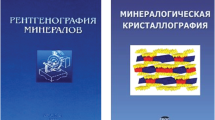Abstract
In 2014 the international scientific community widely celebrated the year of crystallography. This is quite natural, because crystallography holds a particular place among the other sciences. Currently, the most significant scientific findings and technological breakthroughs are made at the intersection of sciences. In other words, the system of highly specialized sciences is making way for interdisciplinary studies. The crystallography methodology developed from copying natural objects to the artificial design of objects having no analogs in nature. This became possible because crystallography is much more than a simple sum of its components; it is convergent in essence, combining analytical methods and achievements in geology, chemistry, physics, and (in the modern stage) biology.
Similar content being viewed by others
Author information
Authors and Affiliations
Corresponding author
Additional information
Original Russian Text © M.V. Kovalchuk, 2014, published in Kristallografiya, 2014, Vol. 59, No. 6, pp. 861–862.
Rights and permissions
About this article
Cite this article
Kovalchuk, M.V. 2014: The international year of crystallography. Crystallogr. Rep. 59, 779–780 (2014). https://doi.org/10.1134/S1063774514060157
Received:
Published:
Issue Date:
DOI: https://doi.org/10.1134/S1063774514060157



